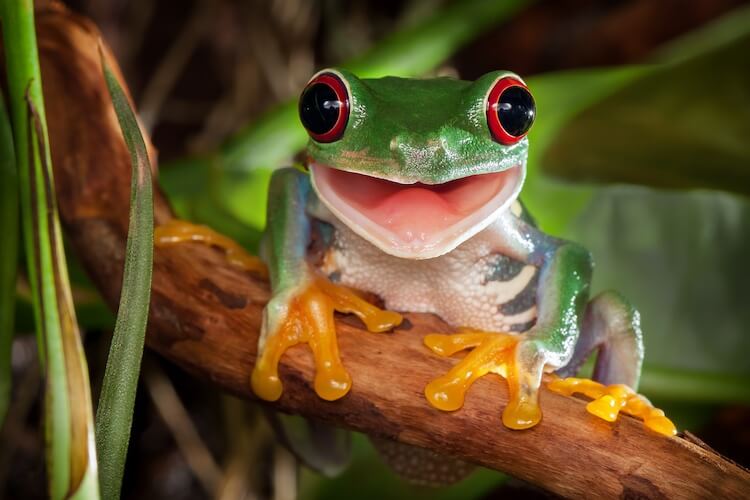
Frogs are a very popular pet, especially with new reptile hobbyists. It is also common to see wild frogs in a garden and want to feed them.
Most frogs eat a diet of only bugs, but this does not mean you can feed them any bug you find crawling around the garden! Pets and wild species have different diets from each other.
It is important to understand their diet before feeding. Many people make feeding mistakes such as feeding bugs they caught in the garden. Others feed prey that is too large, overfeed, or feed dead prey.
To avoid these mistakes, keep reading for a complete guide on what and how to feed a frog.
What Do Frogs Eat?
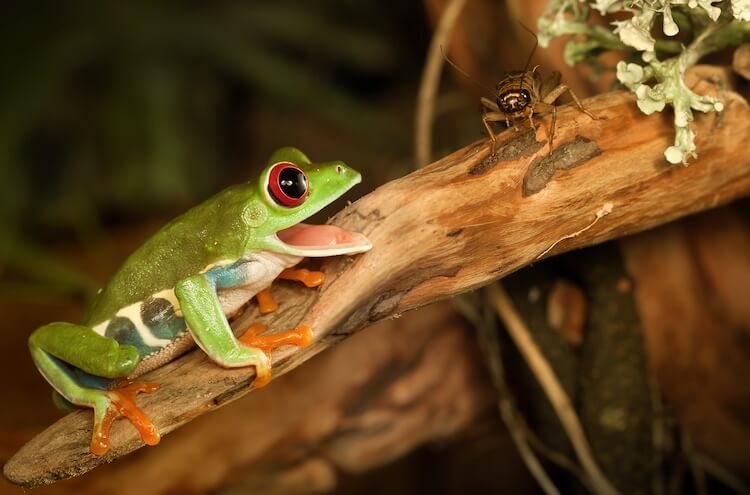
Frogs in the wild are carnivores and will eat insects (e.g. fruit flies and dragonflies), earthworms, caterpillars, beetles, crickets, grasshoppers, snails, slugs, spiders and minnows. Frogs are very opportunistic hunters. They are not really picky about their food and will eat pretty much anything that will fit into their mouths.
Small frogs eat ants, aphids, springtails, mosquito larvae and fruit flies. Larger species like the Pacman frog are also known to eat mice. Aquatic species also eat tadpoles, redworms and mosquito larvae.
Many people think frogs are insectivorous, but this is not true. An insectivore’s diets consist mostly of insects. Since they do not exclusively eat insects, they are carnivores.
Frogs are usually nocturnal hunters. They rely on the cover of darkness to keep them hidden from potential predators.
In the wild they will generally eat as often as they can. Sometimes this means eating several small prey items in a day. If they hunt a grasshopper, or small rodent, this might mean not eating for several days.
They have to find a good balance between conserving energy and using it for hunting effectively.
| Baby Frog | Frog | |
|---|---|---|
| Wild | Plant leaves and roots, mosquito larvae, water striders and other small insects | Beetles, earthworms, crickets, mosquitos, slugs, snails, ants, butterflies, moths, grasshoppers, locusts, minnows, other frogs, small rodents and birds |
| Pet | Bloodworms, redworms, brine shrimp, pinhead crickets, wingless fruit flies | Earthworms, redworms, bloodworms, crickets, mealworms, locusts, grasshoppers, hornworms, waxworms, snails and slugs, minnows and pinky mice |
What Do Baby Frogs Eat?
The diet of baby frogs is very different from adults. Food and prey they eat changes as they grow.
Most tadpoles begin their lives as herbivores and only eat plant matter like algae. As they grow they change from herbivores and become omnivores.
Babies will eat mostly ants, mosquitos, gnats, redworms, fruit flies, and other very small prey.
A challenge for feeding baby frogs is that they have very high metabolisms. This means they digest their food quickly and need to feed multiple times a day.
Growth in baby frogs requires a lot of energy. Babies are constantly on the hunt and need to feed multiple times a day. This helps them grow and increases their chances of survival.
| Tadpole | Baby Frog | |
|---|---|---|
| Wild | Algae and other soft plant matter | Plant leaves and roots, mosquito larvae, water striders and other small insects |
| Pet | Algae wafers, bloodworms and fish food | Bloodworms, redworms, brine shrimp, pinhead crickets, wingless fruit flies |
How Do Frogs Hunt?
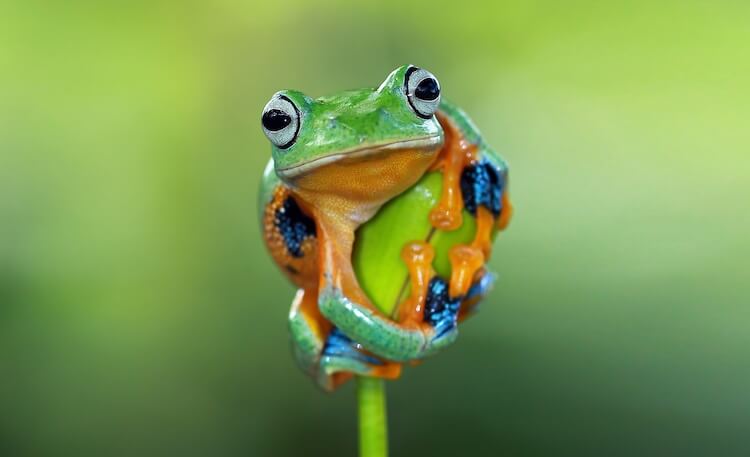
For the most part wild frogs hide and wait to ambush their prey. They remain motionless, and when something tasty passes by them, they pounce.
Many people imagine frogs catching prey with a long, sticky tongue, as this is how frogs are animated in many cartoons. The reality, is quite close.
A frog will flip its tongue out and strike a nearby insect, which then becomes stuck to their tongue. Their tongue is coated in a sticky saliva that helps to trap prey. They then pull back their tongue into their mouth to swallow the prey. Most species only have teeth on the upper jaw, so prey is often swallowed whole rather than chewed.
Frogs that lack a long, sticky tongue will catch food with their front legs. They will grab onto prey with their front feet and stuff it into their mouths before it can wriggle free.
Frog Diet
The diet of a pet is different from what wild frogs eat. As you are deciding to feed a frog, you can be a bit more selective about what to feed in order to keep it as healthy as possible.
Adult pet frogs generally eat insects and other small bugs. Crickets, mealworms, hornworms, waxworms, flightless fruit flies, grasshoppers and pinky mice (for larger individuals) all should be a part of their diet.
They will only eat live prey. They are not scavengers, so they will not recognize dead bugs as something they can eat. You should not feed your frog wild-caught or dead bugs.
The most important thing is that the bugs should be no longer than the distance between the frog’s eyes. This usually measures between 1 to 2 cm for adults. Ideally, the bugs should be gut-loaded.
The same rules apply for feeding baby frogs as adults.
Be sure the prey is no longer than the distance between the frog’s eyes, offer them only live prey, and make sure they are gut-loaded.
When feeding baby frogs you will want to stick with small insects. Pinhead crickets, wingless fruit flies, and bloodworms will be your best bet. It is also easy to find this prey in local pet stores.
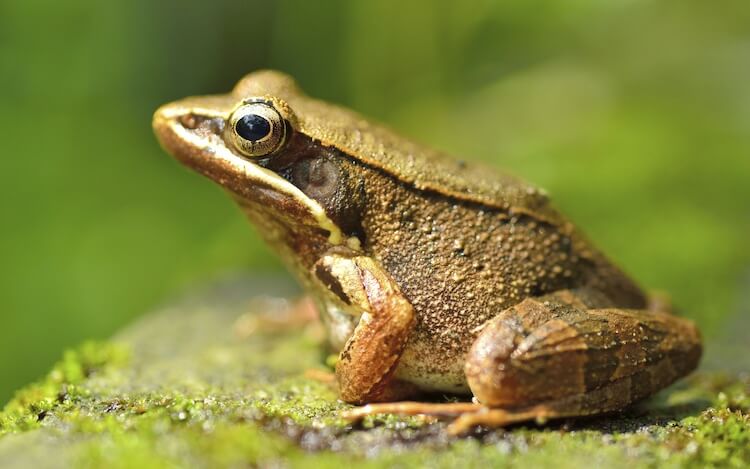
Feeding Frogs
An important part of feeding a frog is supplements. Frogs, like many other reptile, need a calcium supplement to keep them healthy.
Reptile calcium powder is easy to find, but make sure you get one that includes vitamin D3. This will help your frog synthesize the calcium better.
You will also want to gut-load your prey before feeding.
Gut-loading simply means to feed the prey nutritious and vitamin-rich foods in order to increase its nutritional quality before feeding them to your frog. Most pet-stores do not gut-load their insects, this is something you will need to do yourself.
Once you have selected and gut-loaded the prey and purchased a calcium supplement you are ready to feed one.
How To Feed A Frog
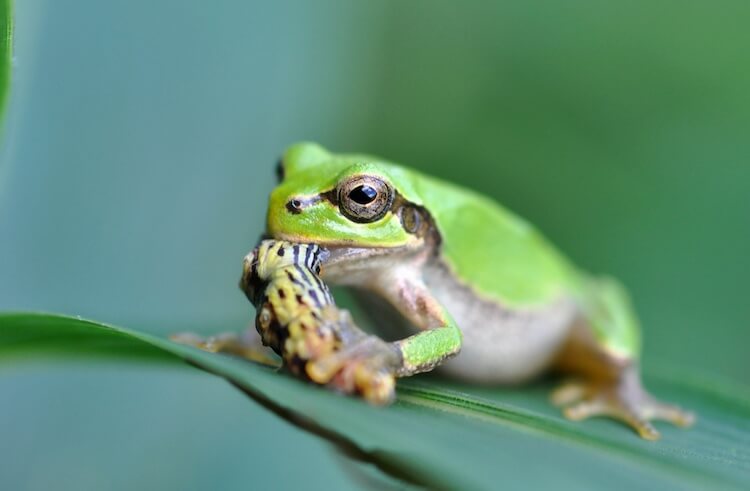
Knowing how to properly feed a frog will help keep it happy, healthy and enriched. It will also make meal times much safer and avoid them being injured by prey.
- Take five crickets and place them into a container you can seal.
- Sprinkle a little bit of calcium powder supplement into the container.
- Gently shake it to thoroughly coat the insects in the calcium.
- Open the enclosure.
- Use tweezers or feeding tongs to drop the insects one at a time into the tank.
- Watch your frog and wait until it has eaten the first insect.
- After it has eaten the first insect, you can drop in the next one.
- Dropping multiple insects at a time can overwhelm them, and allow some prey to escape.
- The feeding session should last for 10 to 20 minutes.
- Anything your frog does not eat within this time period should be removed from the tank.
You should not move the frog into a separate container for feeding. This can cause unnecessary stress, and may result in your frog refusing to eat.
Adult Frog Feeding Schedule
You will want to feed an adult frog every two to three days, although this can vary with their size. Smaller, higher-energy species should be fed every two days, and frogs larger than three inches can be fed three days.
You should feed a varied diet made up of:
- Crickets
- Mealworms
- Grasshoppers
- Locusts
- Minnows
- Brine shrimp
- Pinky mice
- Fuzzy mice (for larger species)
Avoid feeding prey that is dead or larger than the width between their eyes. Also do not feed any wild-caught bugs, fruits, vegetables or human foods. All of these can be harmful.
Crickets and mealworms are generally considered staple foods, but it is good to switch them out for other insects every so often. This helps to provide a more nutritious and varied diet.
Feed your frog approximately five insects per feeding. If your frog eats all of these within 10 minutes, it is safe to offer a few more insects. Likewise, if your frog eats slowly or does not eat all the insects you offer, you can remove them.
Baby Frog Feeding Schedule
Baby frogs are not able to eat the same prey as adults. Their smaller size limits what you can safely feed them. Most people stick to:
- Pinhead crickets
- Bloodworms
- Wingless fruit flies
Since younger frogs have a higher growth rate, they need to be fed much more frequently than adults.
You will want to feed a baby frog twice a day, offer anywhere from five to ten insects per feeding. Again, this will vary depending on the species.
It is important to have as little contact as possible during feeding. The oils in our skin can upset the mucosal layer frogs have on their skin.
Frog Food
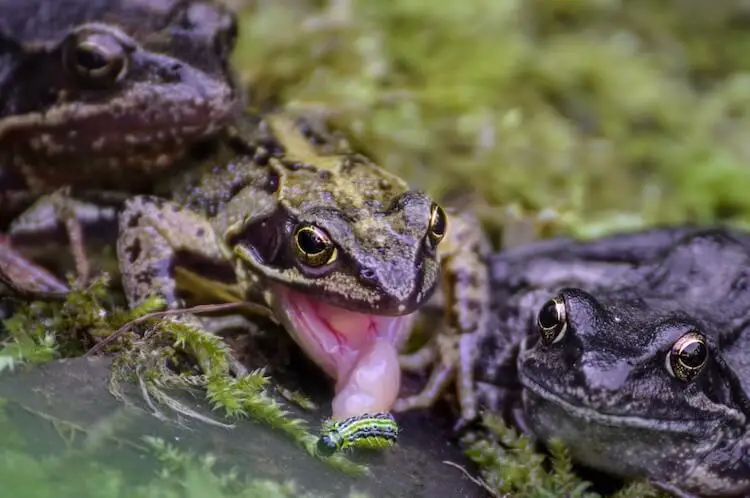
In order to help you feed a frog, we have compiled a comprehensive list of the best foods for frogs.
Keep in mind that you should only feed bugs and prey purchased from a pet store or from a website that sells live feeders for reptiles.
You should not feed wild or dead bugs as they can infect a frog with a parasite or disease. Pet species generally have a much lower resistance to parasites than their wild siblings.
When picking from the frog food list below try and provide variation in their diet. Just feeding one type of insect is not as nutritious as a varied diet. Wild species naturally vary their diet by hunting different prey:
- Mealworms
- Crickets (excellent for any size)
- Hornworms (use as treats)
- Waxworms (use as treats)
- Wingless fruit flies
- Locusts (good for prey variation)
- Grasshoppers
- Snails and slugs
- Brine shrimp (for aquatic species)
- Bloodworms (for baby frogs)
- Minnows
- Pinky mice
- Fuzzy mice (for the African bullfrog)
Remember, when feeding frogs, avoid prey items larger than the distance between their eyes. Feeding prey that is too large could cause your frog to choke while trying to swallow the bug.
What Can’t Frogs Eat?
Frogs eat wide variety of prey, but there is also a long list of foods they cannot eat.
Unlike many lizards, Adult frogs are strictly carnivorous. This means you should not try to feed them fruits or vegetables. Feeding anything other than meat or insects could cause impaction. Impaction is a blockage in the gut which could lead to death within a few days if left untreated.
Frogs cannot have any human foods. Things humans use to season our food (e.g. butter and spices) can be very harmful to a frog. Food made for other animals could pose a choking hazard or contain harmful additives.
Finally, you should avoid feeding any bugs you catch outside or in your house. These bugs could contain parasites and diseases or expose your frog to pesticides. They can make your frog very ill.
Here is a list of foods to avoid feeding your frog:
- Fruits
- Vegetables
- Human food
- Food made for other animals (e.g. kibble)
- Prey larger than the distance between the frog’s eyes
- Wild-caught bugs
Summary
You now know everything you need to know about what do frogs eat.
Frogs in the wild are carnivores. They will normally eat insects, snails, slugs, worms, caterpillars, other frogs, pinky mice, fuzzy mice, and sometimes even small birds.
You can feed a frog various insects, such as crickets, grasshoppers, and locusts, as well as mealworms, bloodworms, hornworms, waxworms, brine shrimp and minnows.
Make sure that you are only feeding prey that is no longer than the distance between their eyes. Avoid feeding human food, food made for other species, wild-caught bugs or food that is too large.
Did you find this guide helpful? Let us know in the comments!

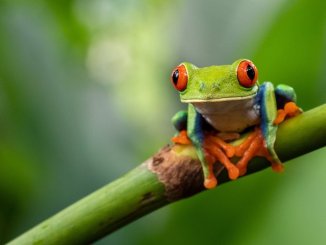
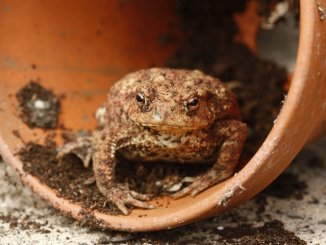
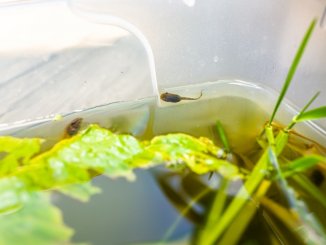

Thank you! This article was very helpful to me and it was easy to understand!! I’m definitely coming back to your site! ???
Can frogs eat rice weevils?
Thank you. This was very informative and easily to understand. I had a TBI ten years ago, and have difficulty understanding things sometimes. But you rock in how you give details. God speed.
How can I take good care of a frog,
Try identifying it! This is quite important. Have you caught it or rescued it in your garden? Which species naturally inhabit your area? Which ones are alien species known to roam your country? Among the options, look for identifying traits that can tell you what you’re dealing with. Once you know the species you will know exactly what it needs if you search for his behavior and habitat. As a general introduction to frogs, you can follow the guide on this article.
Yes it was very helpful. Thanks
Super helpful stuff, easy to understand
I got a new frog and I was doing some research and I read this and it was so understandable and easy to read it really helped thank you
Very thorough article. It told exactly what I needed to know. Thank you.
thx I recently found a bunch of tadpoles and I saved them when the pound was drying out there are becoming froglets and this helped me but can i feed my frogs ham
Nice article. Thank you! I rescued a pile of newly hatched tadpoles and eggs from my pool skimmer basket, in NW Florida several weeks ago. They are thriving and eating well in a 75 gal aquarium, filled only a couple of inches. This past week, several emerged as froglets and the juvenile appear to be some type of tree frog. On the first feeding, I offered tiny roaches to one, and a few ants to another by placing them on the surface of the large rock and large plastic container respectively that they were perched on. The one on the plastic container ate two small ants (we call them sugar ants) and did great. Then it ate a fire ant, larger than the prior prey. The frog grabbed it, make a couple of jerking movements, then I had to step away for a minute. I couldn’t find it when I came back. Several minutes later I found it on the bottom of the tank upside down, apparently dead. I tried to revive it with no success, however it’s eyes were open and other than a lightening in color, appeared normal. I left it on the edge of a small plastic plant container on the screened in porch, just in case it revived. Later that evening it was gone. The only potential “predators” I saw were a cockroach and a palmetto bug in the area.
Will a fire at bite or kill a juvenile tree frog? Could it have chocked? Your thoughts?
Wow, interesting story! Hard to tell what exactly happened, but I wouldn’t rule out ant poison! Fire ants are poisonous and although this shouldn’t be a threat to an adult frog, it might affect a juvenile, that is no expert and might have let the ant bite him.
As an addendum, a couple hundred tadpoles are in the tank, and so far these are the only ones that developed legs. Most of the eggs appeared to be toad eggs (paired strings of eggs) and I was pleasantly surprised to see tree frogs develop.
I intend to release them. When are they old enough or large enough to survive on release?
Oh and by the way, there is no parental care after hatching, so they’re pretty much ready to go! But they are pretty much defenseless as tadpoles, so you would probably increase their chances of survival if you kept them longer.